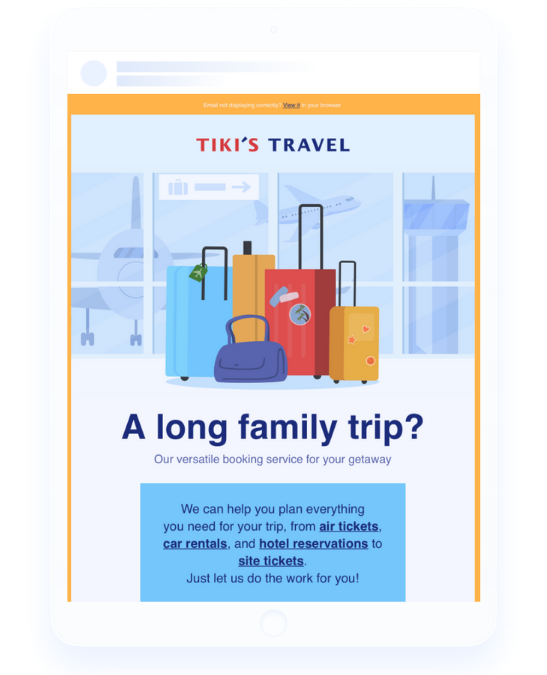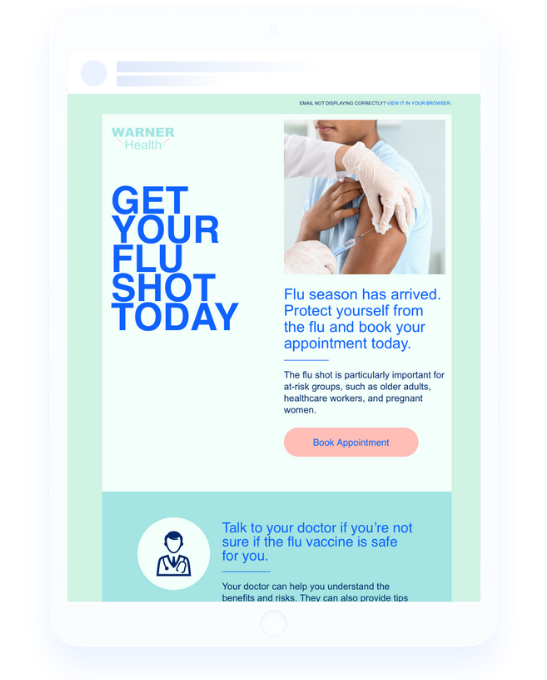What Is an Email Blast? (How to Do It Right)
Time to read: 7 minutes
Email blasts are an important part of any marketing program, but most senders get it wrong.
Email marketing is a powerful tool—when done right. But let's face it: nobody wants to get blasted with anything, especially not emails.
If you're still thinking in terms of "email blasts," it's time for a perspective shift. In this guide, we'll walk you through how to transform your mass emails from impersonal blasts into valuable, targeted campaigns that your subscribers will actually want to open.
Below, we'll teach you everything you need to know about email blasts and how to send them. Follow the tips below to stop blasting your recipients and start providing them with real, personalized value.
What is an email blast?
Email blast (or e-blast) is a term used in email marketing to describe the act of sending a single email message to a large email list simultaneously. The recipients are not typically targeted in a strategic manner—hence why it is referred to as a "blast" and frequently associated as a spammy email.
Email blast definition: to send one email to many people without strategy or segmentation.
This strategy manages to prove itself both effective, but also cringe-worthy at the same time for a few reasons. The term “blast” can imply unexpected aggression and a general lack of tact. And while we’re not advising our senders to stop sending email blasts (we provide an email blast service that allows for this exact type of sending), we think it’s time to reframe how we think about sending them.
This post will cover the following email blast topics:
- Reframing the email blast
- Why using an email service provider is essential
- Sending to clean email list
- Segmenting your email list
- Including a clear call to action
The tips below help internalize your email marketing intentions from the start and ensure that your next email blast will a) get delivered b) convince your recipients to take action.
How to send an email blast
1. Stop calling it an email blast
Take a step back before sending your next email campaign. Think about the meaning behind the email blast.
Does getting blasted with email (or anything for that matter) sound like a good experience? This tip should lay the foundation for how you should think about your email marketing campaigns during the conception phase of your email marketing strategy.
Consider and respect your email subscribers’ time and interest in your brand, and always keep them front of mind when you are designing campaigns. You’re not blasting your recipients—you are providing them with valuable content that may persuade them into paying your brand money.
Did they subscribe to your email newsletter or new product updates? Then don’t call it an email blast—call it your email newsletter campaign or product newsletter.
I, personally, don’t want to be part of any brand’s email blasting strategy—I’d unsubscribe in a heartbeat.
2. Use an email service provider
Now that you’re creating email blast campaigns designed to benefit, not irritate, your recipients, you’ll need to verify that your email reaches their inbox and isn’t getting sent to the spam folder or bounced entirely. Email Service Providers (ESPs) reduce the hassle related to email delivery so you can focus on your campaign’s content and strategy.
The larger your list grows, the more important it is to rely on dependable and fast ESPs. ESPs also monitor the IP that you send email from and let you know if something is up and may be affecting your email deliverability.
From the get-go, you might send email blasts to learn more about your audience. Once the data starts rolling in, you can begin segmenting your recipients into different lists based on their behavior (more on that soon).
Email service providers can also provide you with:
- Pre-built email templates
- Landing pages
- Drag-and-drop design editors
- Email automation tools
- Digital marketing tools
- Customer relationship management (CRM)
3. Send to a clean email list
By now it should go without saying—but it’s always worth reemphasizing—any email list you haven’t built with permission marketing tactics jeopardizes your ability to send any email at all (not to mention it kills your relationship with your recipients).
SendGrid doesn’t allow customers to send email to purchased email lists. This protects you and everyone who uses SendGrid to send email. For strategies on list building, read How How to Build an Email List From Scratch.
4. Personalize your list with segmentation
A pillar of content and copywriting is to write as if you’re speaking to one single person at a time. This isn’t feasible with mass email marketing, but segmenting your list and messages helps attain the same sort of feeling. Email marketing segmentation transforms generic emails into personalized and tailored messages more likely to resonate with your recipients.
It doesn’t matter if you’re a huge ecommerce brand, small business, or a local mom-and-pop shop—the way you speak to your customers matters.
Luckily, it’s never been easier to accomplish this. Modern email marketing software allows you to efficiently segment your messages to recipients based on a number of factors and metrics, such as:
- Age
- Gender
- Region
- Past email
- Open rate
- Click-Through rate
- Conversion rate
Use A/B testing to see what resonates most with your audience. Creating multiple email subject lines and content with different email designs automatically shifts it from a blast to a more personalized experience.
Start segmenting from the get-go with a well-designed welcome email.
Twilio SendGrid offers all of these segmentation capabilities in our own email marketing tool, Marketing Campaigns. If you're interested in learning about how to leverage your segmentation with automation, try out SendGrid's Marketing Automation tool.
5. Include a clear call to action
If you’ve managed to convince your recipient to open one of your promotional emails, nice work. Take 3 seconds to celebrate. But this is only the start. What are you asking them to do once you’ve grabbed their attention?
Without a compelling call to action (CTA), all your effort and planning will sadly be for nothing. How you craft your CTAs will depend on the action you want the recipient to take. And yes, there’s a guide for creating strong email CTAs. Download it here.
Email blast examples and templates
Looking for some real-world inspiration? We've compiled a short list of email blast examples and templates to show you what it looks like in action. Feel free to download any of these templates to build your own campaigns to send email blasts:.
Remember, these aren't "blasts" in the traditional sense—these email blast examples are strategic, targeted campaigns designed to engage specific audience segments.
Ecommerce newsletter email blast template


This template showcases how an ecommerce brand might approach a newsletter:
- Clean, visually appealing design with clear product images
- Personalized greeting (e.g., "Hi [First Name]")
- Featured products or categories tailored to the recipient's interests
- Clear call-to-action buttons for each product
- Brief, compelling copy that highlights key selling points
Travel promotional email blast template


This template demonstrates how a travel company might promote a special offer:
- Eye-catching hero image of a desirable destination
- Limited-time offer prominently displayed
- Bulleted list of key benefits or features of the deal
- Social proof (e.g., customer testimonials or ratings)
- Urgency-inducing language to encourage quick action
Healthcare seasonal email blast template


This template shows how a healthcare provider might send a seasonal update:
- Friendly, reassuring tone appropriate for healthcare communications
- Seasonal health tips or reminders
- Information about relevant services or products
- Clear contact information or scheduling options
- Trustworthy design with appropriate use of medical imagery
Should you use an email blast service?
Well, it depends on how you're using the email blast service. In some ways, SendGrid could be used as an email blast service—but we (and your customers) would prefer you get a bit more targeted and intentional with your email campaigns.
Here's why a more strategic approach is better:
- Improved engagement: Targeted emails are more likely to resonate with recipients, leading to higher open and click-through rates.
- Better deliverability: Sending relevant content to interested subscribers helps maintain a good sender reputation.
- Increased ROI: When you send the right message to the right people, you're more likely to see a return on your investment.
So, how can you use an email service more strategically? Consider these tips:
- Segment your list: Divide your subscribers based on demographics, behavior, or preferences.
- Personalize content: Use subscriber data to tailor your messages and offers.
- Test and optimize: Regularly A/B test your emails and use the insights to improve future campaigns.
- Focus on value: Every email should provide something useful or interesting to the recipient.
Remember, the goal isn't to blast your message to as many people as possible. It's about creating meaningful connections with your audience through relevant, personalized content. While SendGrid provides the tools to send large volumes of emails, we encourage you to use these capabilities wisely.
By shifting from an "email blast" mindset to a more targeted approach, you'll not only see better results from your campaigns—you'll also build stronger, more valuable relationships with your subscribers.
Happy email (blasting) sending!
The email blast tips mentioned above are meant to get you on the right path for sending successful email campaigns. There’s certainly more to consider and more time to spend on elements like clever and engaging subject lines and beautiful, reader-friendly designs.
Here's a quick recap of the key takeaways:
- Ditch the "blast" mindset: think targeted campaigns, not shotgun approach
- Use an email service provider to improve deliverability and gain insights
- Keep your list clean and permission-based
- Segment and personalize for better engagement
- Craft clear, compelling calls-to-action
But knowing is only half the battle—now it's time to put these ideas into action.
Whether you're just starting out or looking to refine your existing strategy, SendGrid has the tools and expertise to help you succeed. Our platform offers everything from basic sending capabilities to advanced segmentation and automation features.
Ready to transform your email marketing? Sign up for SendGrid today and start sending emails that truly connect.
And in the meantime, let’s put the phrase email blast to eternal rest.


Related Posts
Related Resources
Twilio Docs
From APIs to SDKs to sample apps
API reference documentation, SDKs, helper libraries, quickstarts, and tutorials for your language and platform.
Resource Center
The latest ebooks, industry reports, and webinars
Learn from customer engagement experts to improve your own communication.
Ahoy
Twilio's developer community hub
Best practices, code samples, and inspiration to build communications and digital engagement experiences.

